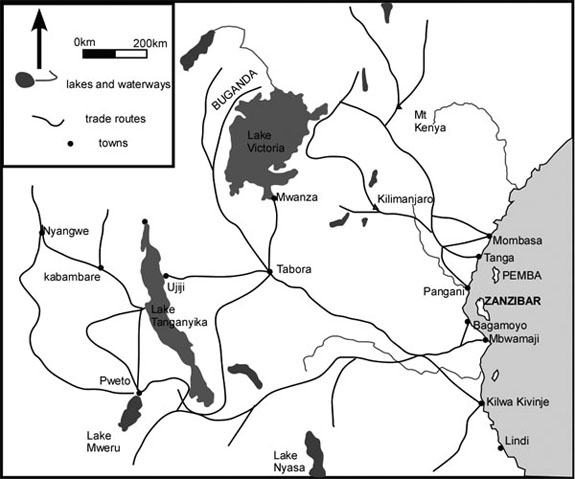CHAPTER EIGHT: THE LONG DISTANCE TRADE
Before thecoming in of Europeans and the colonization of Africa, Africans engaged themselves in trade and this trade was of two types; local and long distance trade. Local Trade dealt mainly in locally produced commodities like foodstuffs, baskets, nets, arrows, fish, spears and other iron implements and was carried out within the same political unit, sometimes local trade was between many political entities.
A market centre would be established in a given region and operated on a particular day every given month. Some of the these markets would be found in places like Mengo in Buganda, Rubaga in Bugangaizi, Katwe in Toro and many others were established in the present capital towns and cities like Dar-es-Salaam, Tabora, Ujiji, Nairobi, Mombasa, Machakos in Kenya.

The methodsof buying and selling these goods was by barter trading, a system that went on until the introduction of the forms of media of exchange for example cowrie shells.
However, the first half of the 19th Century saw the emergence of Long Distance Trade in East Africa.
Lond distance trade has been defined as the commercial interaction between alien communities separated by considerable distances. This trade involved a number of communities among which included the Baganda, Banyoro, Nyamwezi, Yao, Ngoni, Arabs and Swahili traders.

There were also the Kamba, Luyia, Taitas, Chagga, Kasongo of Zaire, people of the Katanga, Mwenomotapa, people of Malawi among others.
Long distance trade means the pre-colonial trade between Arabs and Africans that took place by use of caravans that moved long distances in case of East Africa.
This trade took place mainly during dry seasons because farmers could not concentrate on agriculture. This trade involved many African societies Yao, Nyamwezi, Kamba, Kikuyu, Baganda, Banyoro among others
The commodities involved included Ivory, slaves, animal skins among others from Africa. Beads, glass, hardware, gun power, cloth among others from abroad. The medium of exchange was by barter trade but later currency was introduced.
The commodities involved from the interior of East Africa and Central included ivory, skins, gold and later on slaves and from the coast European commodities like guns, beads, cloth, mirrors were imported.

Like in Local Trade the means of exchange was barter which involved the exchange of goods for goods but with time this means of exchange became difficult because of lack of double coincidence, bulky commodities, divisions etc. Therefore a form of currency; cowrie shells was introduced as media of exchange during Long Distance Trade.

The main trading market places included in the case of East Africa Karagwe, Tabora, Dar-es-Salaam, Kilwa, Mombasa and Zanzibar. In case of Central Africa, the headquarters of Mwanamotapa and Mwana-Ya-Mawa kingdom, Maputo, Luanda, Lusakaand others were used.
Factors that led to the growth ofthe long distance trade
Characteristics of the Long distance trade
Problems faced by the long distance traders
Role of the Baganda in Long Distance Trade
The Yao in the long distance trade
The Impact of long distance treade
Reasons for the collapse of Long Distance Trade
Why did the Arabs had little interest in the interior of East Africa up 1840?
[1] From G. St. J. Orde. 1925. The Vanishing Tribes of Kenya. Philadelphia: J.B. Lippincot.
Licensed under the Developing Nations 2.0
A Complete East African History ebook